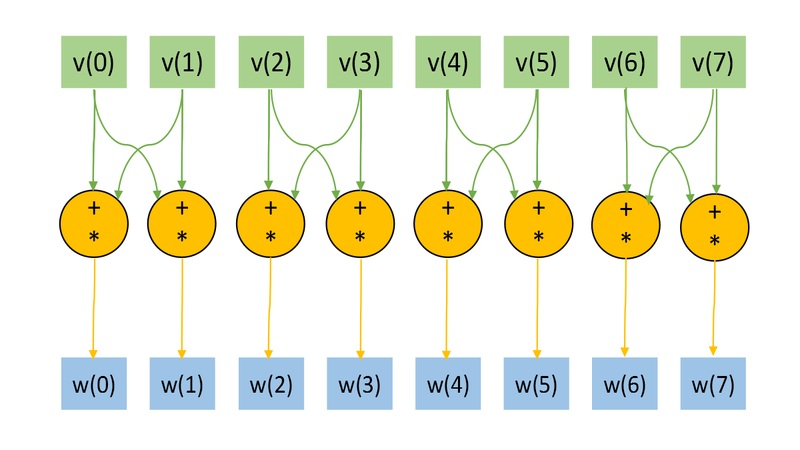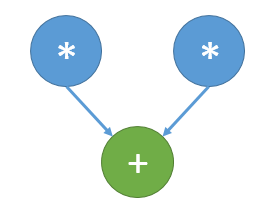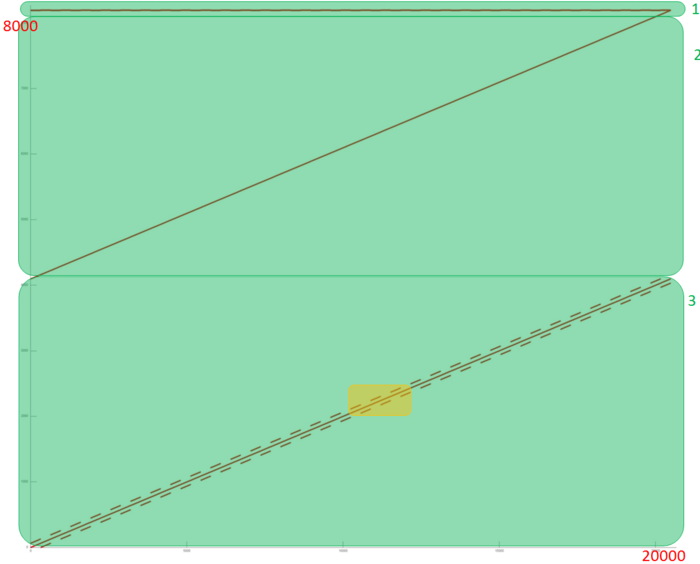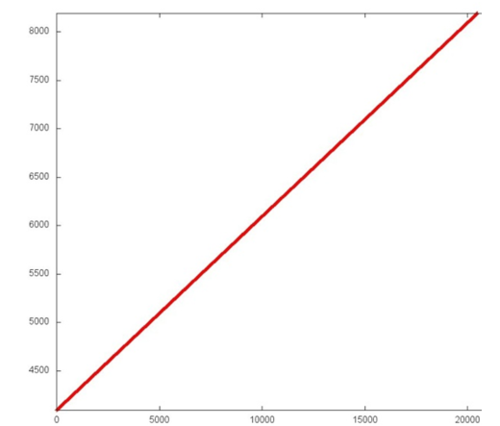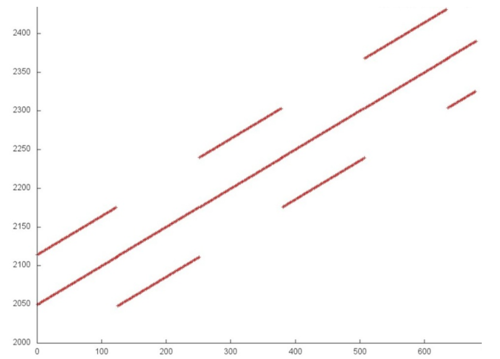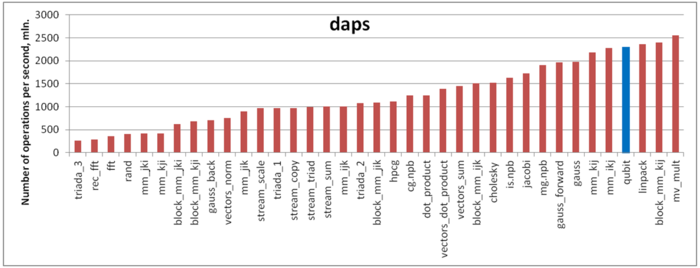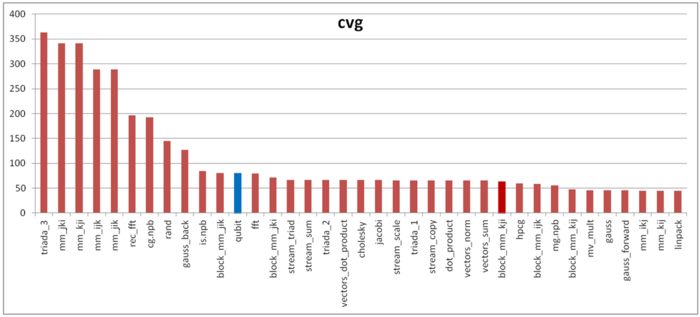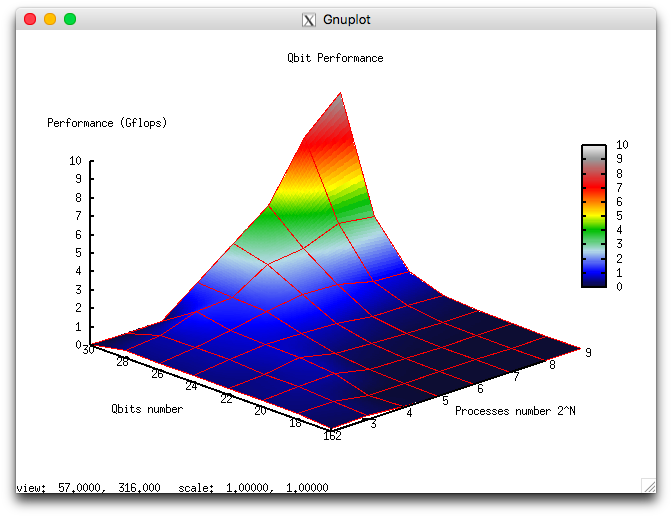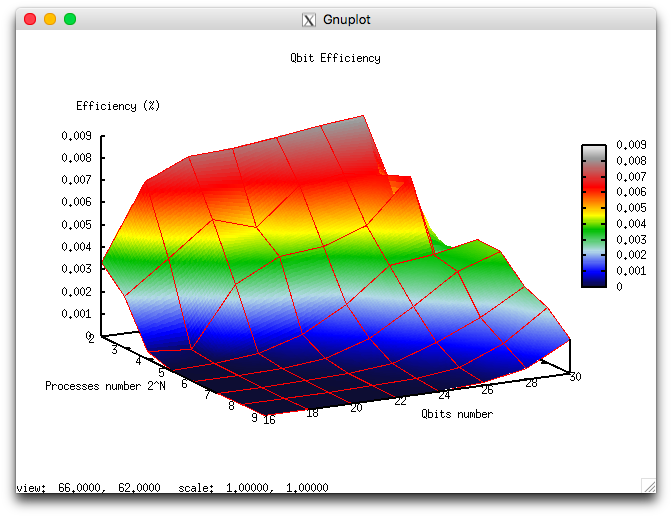Single-qubit transform of a state vector
| Single-qubit transform of a state vector | |
| Sequential algorithm | |
| Serial complexity | [math]3 \cdot 2^n[/math] |
| Input data | [math]2^n+4[/math] |
| Output data | [math]2^n[/math] |
| Parallel algorithm | |
| Parallel form height | [math]2[/math] |
| Parallel form width | [math]2^{n+1}[/math] |
Primary authors of this description: A.Yu.Chernyavskiy, Vad.V.Voevodin (Section 2.2)
Contents
- 1 Properties and structure of the algorithm
- 1.1 General description of the algorithm
- 1.2 Mathematical description of the algorithm
- 1.3 The computational kernel of the algorithm
- 1.4 Macro structure of the algorithm
- 1.5 Implementation scheme of the serial algorithm
- 1.6 Serial complexity of the algorithm
- 1.7 Information graph
- 1.8 Parallelization resource of the algorithm
- 1.9 Input and output data of the algorithm
- 1.10 Properties of the algorithm
- 2 Software implementation of the algorithm
- 2.1 Implementation peculiarities of the serial algorithm
- 2.2 Locality of data and computations
- 2.3 Возможные способы и особенности параллельной реализации алгоритма
- 2.4 Scalability of the algorithm and its implementations
- 2.5 Dynamic characteristics and efficiency of the algorithm implementation
- 2.6 Conclusions for different classes of computer architecture
- 2.7 Existing implementations of the algorithm
- 3 References
1 Properties and structure of the algorithm
1.1 General description of the algorithm
The algorithm simulates an action of a single-qubit quantum gate on a state vector. [1] [2] [3]
This algorithm is often a subroutine and is used iteratively to the different qubits of a state. For example, it's used for the quantum algorithms simulation and the analysis of quantum entanglement. As for the most of the classical algorithms in quantum information science, the described algorithm shows the exponential data growth with respect to the number of qubits. This fact leads the necessity of a supercomputer usage for the practically important tasks.
1.2 Mathematical description of the algorithm
Input data:
Integer parameters [math]n[/math] (the number of qubits) and [math]k[/math] (the number of the affected qubit).
A complex [math]2 \times 2[/math] matrix [math]U = \begin{pmatrix} u_{00} & u_{01}\\ u_{10} & u_{11} \end{pmatrix}[/math] of a single-qubit transform.
A complex [math]2^n[/math]-dimensional vector [math]v,[/math] which denotes the initial state of a quantum system.
Output data: the complex [math]2^n[/math]-dimensional vector [math]w,[/math] which corresponds to the quantum state after the transformation.
The single-qubit transform can be represented as follows:
The output state after the action of a transform [math]U[/math] on the [math]k-[/math]th qubit is [math]v_{out} = I_{2^{k-1}}\otimes U \otimes I_{2^{n-k}},[/math] where [math]I_{j}[/math] is the [math]j-[/math]dimensional identity matrix, and [math]\otimes[/math] denotes the tensor (Kronecker) product.
However, the elements of the output vector can be represented in more computationally useful direct form:
- [math] w_{i_1i_2\ldots i_k \ldots i_n} = \sum\limits_{j_k=0}^1 u_{i_k j} v_{i_1i_2\ldots j_k \ldots i_n} = u_{i_k 0} v_{i_1i_2\ldots 0_k \ldots i_n} + u_{i_k 1} v_{i_1i_2\ldots 1_k \ldots i_n} [/math]
A tuple-index [math]i_1i_2\ldots i_n[/math] denotes the binary form of an array index.
1.3 The computational kernel of the algorithm
The computational kernel of the single-qubit transform can be composed of [math]2^n[/math] calculations of the elements of the output vector [math]w.[/math] The computation of each element consists of two complex multiplication and one complex addition opearations. Moreover we need to compute an indexes [math]i_1i_2\ldots 0_k \ldots i_n,[/math] and the [math]i_k[/math] bits, these computations needs the bitwise operations.
1.4 Macro structure of the algorithm
As noted in the description of the computational kernel, the main part of the algorithm consists of the independent computations of the output vector elements.
1.5 Implementation scheme of the serial algorithm
For [math]i[/math] from [math]0[/math] to [math]2^n-1[/math]
- Calculate the element [math]i_k[/math] of the binary representation of the index [math]i.[/math]
- Calculate indexes [math]j[/math] with binary representation [math]i_1i_2\ldots \overline{i_k} \ldots i_n,[/math] where the overline denotes the bit-flip.
- Calculate [math]w_i = u_{i_k i_k}\cdot v_{i} + u_{i_k \overline{i_k}}\cdot v_j.[/math]
1.6 Serial complexity of the algorithm
The following number of operations is needed for the single-qubit transform:
- [math]2^{n+1}[/math] complex multiplications;
- [math]2^n[/math] complex additions;
- [math]2^n[/math] [math]k[/math]-th bit reads;
- [math]2^n[/math] [math]k[/math]-th bit writes.
Note, that the algorithm are often used iteratively, that's the the bit operations (3-4) can be performed once in the beginning of computations. Moreover, they can be avoided by the usage of additions and bitwise multiplications with the [math]2^k,[/math] that can be also calculated once for each [math]k.[/math]
1.7 Information graph
The Figs. 1 and 2 shows the information graph for the paramters [math]n=3, k=1[/math] and [math]n=3, k=2.[/math] The graphs are presented without a transformation matrix [math]U,[/math] because its small size in comparison with a input and output data. Fig.3 shows the main operation, which is denoted by orange on Figs.1-2.
The representation with an input and data and the "folded" triple operation is useful for the understanding of the memory locality. Note, the the structure of an information graph strongly depends on the parameter [math]k.[/math]
1.8 Parallelization resource of the algorithm
As we can see on the information graph, the direct algorithm of one-qubit transform simulation has the very high parallelization resource, because all computations of different output vector elements can be made independently. Two multiplication operations needed for the computation of each output vector element also can be done in parallel.
So, there are only two levels of computations:
- [math]2^{n+1}[/math] multiplications.
- [math]2^n[/math] additions.
1.9 Input and output data of the algorithm
Input data:
- [math]2^n[/math]-dimensional complex state vector [math]u.[/math] In most cases thу vector is normalized to 1.
- [math]2[/math]-dimensional unitary matrix [math]U[/math].
- The number (index) of the affected qubit [math]q[/math].
Output data:
- The [math]2^n[/math]-dimensional complex output state vector [math]w.[/math].
Amount of input data: [math]2^n+4[/math] complex numbers and [math]1[/math] integer parameter.
Amount of output data: [math]2^n[/math] complex numbers.
1.10 Properties of the algorithm
The ratio of the serial complexity to the parallel complexity is exponential (an exponent transforms to a constant).
The computational power of the algorithm considered as the ratio of the number of operations to the amount of input and output data is constant.
2 Software implementation of the algorithm
2.1 Implementation peculiarities of the serial algorithm
The function of the single-qubit transform may be represented in C language as:
void OneQubitEvolution(complexd *in, complexd *out, complexd U[2][2], int nqubits, int q)
{
//n - number of qubits
//q - index of the affected qubit
int shift = nqubits-q;
//All bits are zeros, except the bit correspondent to the affected qubit.
int pow2q=1<<(shift);
int N=1<<nqubits;
for (int i=0; i<N; i++)
{
//Making the changing bit zero
int i0 = i & ~pow2q;
//Setting the changing bit value
int i1 = i | pow2q;
//Getting the changing bit value
int iq = (i & pow2q) >> shift;
out[i] = U[iq][0] * in[i0] + U[iq][1] *in[i1];
}
}
Note, that the huge part of the computation and code logic consists of the bit operations, but this can be avoided. In most cases, single-qubit transform is just as a subroutine and is used sequentially many times. Moreover, indexes i0, i1, and iq depends only on the parameters n and q. The n is fixed, and we can calculate these indexes in the beginning of computations for every parameter q, and we need only 3n integers to store the data, when the input and output data growths exponentially. It's obvious that such optimization is critically needed for the implementations of the algorithm for the hardware and software with slow bit operations (for example, Matlab).
2.2 Locality of data and computations
Despite of the great parallelization resource, practical implementations have a bad locality.
From the mathematical description and information graphs for the different parameter q (the number of affected qubit), we can see for the single work of the algorithm it's easy to achieve the ideal locality by the permutation of qubits. Thus, if we move the q-th qubit to the last place, we achieve the sequential transfers only between local elements.
However, the single-qubit transform is almost always used sequentially as a subroutine on a common state with different parameter q. As we can see from the mathematical description and Figs. 1-2, it is impossible to achieve good locality.
2.2.1 Locality of implementation
2.2.1.1 Structure of memory access and a qualitative estimation of locality
As it was mentioned above, the locality of computations depends on the parameter q (the index of the affected qubit). Firstly, let's examine the memory access for the fixed parameter q (n=12, q=6). A memory access profile is illustrated in Fig. 4. The profile consists of the accesses to three different arrays, these arrays are emphasized on Fig. 4 by the green color. We can see that for the fragmets 2 and 3 memory accesses don't repeat, but the are closely situated. Let's examine the fragments closely.
The fragment 1 is shown on Fig. 5. This array corresponds to the transformation matrix and consists only of 4 elements, so the locality is very high.
The fragment 2 (Fig. 5) shows the simple sequential access to all the array elements. Such fragment has very high spatial and very low time locality (data isn't accessed repeatedly).
The fragment 3 is most interesting. Its part is shown on Fig. 7. Here we can see again the sequential access to the array elements, but with parallel access to elements with higher or lower virtual addresses.
Now, let's examine the dependence of the memory-access profile on the parameter q (the number of affected qubit). Fig. 8 shows the profile for different values of the parameter. As we can see, the fragments 1 and 2 don't change, but the third fragment change its shift for the parallel access. This makes it difficult to effectively implement the algorithm for the distributed memory.
2.2.1.2 Количественная оценка локальности
Основной фрагмент реализации, на основе которого были получены количественные оценки, приведен здесь (функция Kernel). Условия запуска описаны здесь.
Первая оценка выполняется на основе характеристики daps, которая оценивает число выполненных обращений (чтений и записей) в память в секунду. Данная характеристика является аналогом оценки flops применительно к работе с памятью и является в большей степени оценкой производительности взаимодействия с памятью, чем оценкой локальности. Однако она служит хорошим источником информации, в том числе для сравнения с результатами по следующей характеристике cvg.
На рисунке 5 приведены значения daps для реализаций распространенных алгоритмов, отсортированные по возрастанию (чем больше daps, тем в общем случае выше производительность). Можно увидеть, что производительность работы с памятью для этой программы высока – значение daps примерно на уровне теста Linpack. Видимо, низкая временная локальность в данном случае компенсируется высокой пространственной локальностью.
Вторая характеристика – cvg – предназначена для получения более машинно-независимой оценки локальности. Она определяет, насколько часто в программе необходимо подтягивать данные в кэш-память. Соответственно, чем меньше значение cvg, тем реже это нужно делать, тем лучше локальность.
На рисунке 6 приведены значения cvg для того же набора реализаций, отсортированные по убыванию (чем меньше cvg, тем в общем случае выше локальность). Можно увидеть, что, в отличие от daps, cvg оценивает локальность данной программы как достаточно низкую. В частности, значение cvg для Linpack заметно меньше, в то время как значения daps практически совпадали.
Одна из возможных причин этого – влияние арифметических операций. Может получиться, что данные из памяти не будут запрашиваться, пока арифметические операции не будут выполнены; это приводит к простою подсистемы памяти. Соответственно, если в одной программе таких операций нет, а в другой - есть, то daps в первом случае будет выше. При этом cvg не поменяется, поскольку эта оценка не зависит от времени выполнения.
В данном случае арифметических операций практически нет (в отличие от некоторых других программ), поэтому daps может показывать более высокие результаты, в то время как cvg показывает достаточно низкую оценку.
2.3 Возможные способы и особенности параллельной реализации алгоритма
Основной способ параллельной реализации очевиден - необходимо распараллеливание основного цикла (параллельное вычисление различных компонент выходного вектора-состояния) и, желательно, операций умножения. На машинах с общей памятью такой вариант распараллеливания приводит к ускорению, близкому к максимально-возможному. Однако, данный способ сталкивается с проблемами локальности данных. Анализируя математическая описание и информационные графы алгоритма легко видеть, что при использовании большого числа узлов с собственной памятью количество необходимых пересылок между узлами становится сопоставимым с количеством вычислений, что приводит к существенной потере эффективности. Возможны разные пути частичного решения этой проблемы, например, кэширование или использование парадигмы программирования SHMEM, однако, столь сильная нелокальность использования данных всё равно не позволяет добиться хорошей эффективности.
2.4 Scalability of the algorithm and its implementations
2.4.1 Scalability of the algorithm
2.4.2 Scalability of the algorithm implementation
Because of the constant height of the parallel form the algorithm is very good scalable for the shared memory implementation. But the usage of the distributed memory leads to the locality problems.
Let us perform a scalability analysis of a particular implementation of the Cholesky algorithm according to the scalability methodology with the use of the Lomonosov supercomputer[4] installed at the Research Computing Center of Moscow State University.
- the number of processors [4 : 512] with the powers of 2 step;
- the number of qubits [16 : 32] with step 2.
- minimum 0.000003%;
- maximum 0.008%.
The following Figures illustrate the performance and efficiency of the chosen parallel implementation of the Cholesky algorithm, depending on the startup parameters.
for the efficiency are shown at Figure 2b. It can be seen, that efficiency is quite low, but it grows fast with the number of qubits and remains constant with simultaneous increasing of the number of processors and qubits.
The following parallel implementation of the algorithm was used: parallel impplementation of single-qubit transform.
2.5 Dynamic characteristics and efficiency of the algorithm implementation
The implementation of the algorithm used for the analysis is available here. All results were obtained on the "GraphIT!" supercomputer. For the experiments we used the Intel Xeon X5570 processors with 94 Gflops peak performance and the Gnu 4.4.7 compiler.
The CPU usage diagram shows that the average CPU usage during almost all the runtime of the program is about 50%. This fact shows high load, when 8 processes works on 8 processors without HyperThreading technology. It means, that the usage of all physical cores is near to 100%.
Diagram for the number of floating point operations per second shows high performane. The peak performance is 300 mln. flops, and about 70 mln. flops on average between nodes. This fact may indicate the disbalance of the computations with rather high performance.
The diagram for the number of L1 cache-misses shows a high number of misses (4 mln/sec for some processe and 1 mln/sec on average). It indicates the high intensity and locality, and the disbalance of computations among processors.
The diagram for the number of L3 cache-misses still shows rather high number of misses (1 mln/sec at the peek and 0.25 mln/sec on average). The of L1/L3 misses is about 4 and it is average for the class of the same tasks. This value also shows low locality of computations.
The diagram for the number of memory read operations shows low activity of memory reads. Because of the big number of working processes, the difference between peak and average value of the activity shows the computations are unbalanced. The activity is lower than for typical software of the same class.
The activity of write operations is low, as it can be expected.
The plot of the number of processes ready for the execution (LoadAvg) shows that this value remains constant and approximately equals 3 throughout the program run. This shows that the program is operating in a stable manner, with small number of processes on each node. It confirms the suggestion about the disbalance of computations and shows that some processes have low activity.
Overall, the data obtained from the monitoring system allows one to come to the conclusion that the program under study works with low efficiency, but with the load disbalance. So, the program can be possibly optimized by the improvement of the processors balance.
2.6 Conclusions for different classes of computer architecture
Because of the very high parallelization possibility, but low locality, the effective and good scalable parallel implementation of the algorithm can be achieved for the shared memory. But the usage of distributed memory leads to the efficiency problems and necessity of special tricks for the optimization. It may be noted, that this task is a very good test platform for the development of methods for the data intense tasks with bad locality.
2.7 Existing implementations of the algorithm
The algorithm is implemented (mostly serial versions) in different libraries for quantum information science and quantum computer simulation. For example: QLib, libquantum, QuantumPlayground, LIQUi|>.
3 References
- ↑ Kronberg D. A., Ozhigov Yu. I., Chernyavskiy A. Yu. Algebraic tools for quantum information. (In Russian)
- ↑ Preskill J. Lecture notes for physics 229: Quantum information and computation //California Institute of Technology. – 1998.
- ↑ Nielsen, Michael A., and Isaac L. Chuang. Quantum computation and quantum information. Cambridge university press, 2010.
- ↑ Voevodin Vl.V., Zhumatii S.A., Sobolev S.I., Antonov A.S., Bryzgalov P.A., Nikitenko D.A., Stefanov K.S., Voevodin Vad.V. The Lomonosov supercomputer in practice. Otkrytye Sistemy (2012) No. 7, 36-39.
